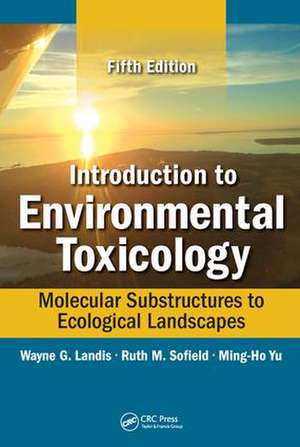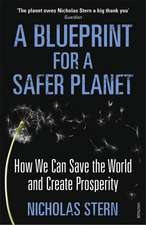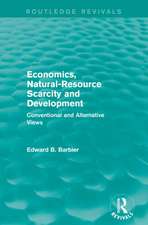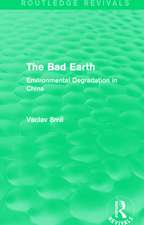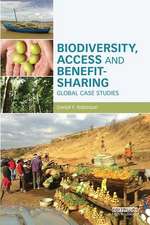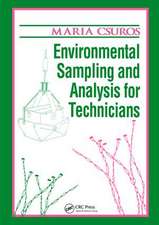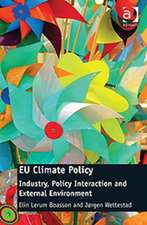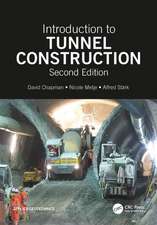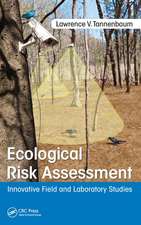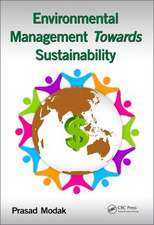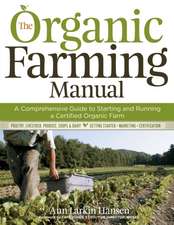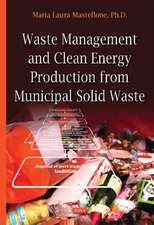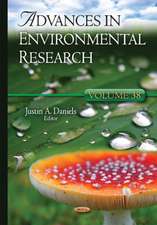Introduction to Environmental Toxicology: Molecular Substructures to Ecological Landscapes, Fifth Edition
Autor Wayne Landis, Ruth Sofield, Ming-Ho Yuen Limba Engleză Hardback – 25 sep 2017
Preț: 665.57 lei
Preț vechi: 921.85 lei
-28% Nou
Puncte Express: 998
Preț estimativ în valută:
127.40€ • 138.43$ • 107.08£
127.40€ • 138.43$ • 107.08£
Carte tipărită la comandă
Livrare economică 21 aprilie-05 mai
Preluare comenzi: 021 569.72.76
Specificații
ISBN-13: 9781498750424
ISBN-10: 1498750427
Pagini: 490
Ilustrații: 66 Line drawings, color; 101 Line drawings, black and white; 13 Halftones, color; 2 Halftones, black and white; 63 Tables, black and white
Dimensiuni: 178 x 254 x 31 mm
Greutate: 1.16 kg
Ediția:5 New edition
Editura: CRC Press
Colecția CRC Press
ISBN-10: 1498750427
Pagini: 490
Ilustrații: 66 Line drawings, color; 101 Line drawings, black and white; 13 Halftones, color; 2 Halftones, black and white; 63 Tables, black and white
Dimensiuni: 178 x 254 x 31 mm
Greutate: 1.16 kg
Ediția:5 New edition
Editura: CRC Press
Colecția CRC Press
Cuprins
Chapter One: Introduction to Environmental Toxicology. Chapter Two: Frameworks and Paradigms for Environmental Toxicology. Chapter Three: Overview of Toxicity Testing Methods. Chapter Four: The Analysis of Exposure-Response. Chapter Five: The Fate and Transport of Contaminants. Chapter Six: Uptake and Modes of Action. Chapter Seven: Modification in Toxic Responses, Mixtures and Climate Change. Chapter Eight: Inorganic Gaseous Pollutants. Chapter Nine: Fluoride as a Contaminant of Developing Economies. Chapter Ten: Metals. Chapter Twelve: Biotransformation, Detoxification, and Biodegradation. Chapter Thirteen: Ecological Effects from Biomarkers to Populations. Chapter Fourteen: Ecological Effects: Community to Landscape Scales of Toxicological Impacts. Chapter Fifteen: Ecological Risk Assessment. Index.
Notă biografică
Since 1989, Wayne Landis has been the Director of the Institute of Environmental Toxicology and Chemistry, part of Huxley College of the Environment at Western Washington University. He is a graduate of Wake Forest University with a BA in Biology in 1974. He received an MA and a Ph.D. in Zoology from Indiana University in 1978 and 1979, respectively. He has authored over 120 publications and 300 scientific presentations. Dr. Landis has served on numerous committees and consulted for industry; NGOs; print and electronic media; and federal (U.S. and Canada), state, provincial, and local governments. In 2007 he was selected as a Fellow of the Society for Risk Analysis.
Dr. Landis has had a varied research program. During the 1980s and early 1990s he discovered and characterized enzymes that degrade organophosphates, and bacteria that metabolize riot control materials. He also conducted an extensive research program using microcosms to investigate the effects of jet fuels and other materials on the dynamics of ecological structures. Using patch dynamics models he also formulated the theory of how to incorporate landscape scale effects as part of environmental toxicology. He is the co-developer of the Community Conditioning Hypothesis, and the Action at a Distance Hypothesis. Currently his efforts have been to apply ecological risk assessment at regional and landscape scales using the relative risk model. The use of the relative risk model has now been applied to contaminated sites, invasive species, forestry and species conservations. The model has been used to estimate risk to sites across the world.
He has been the lead or co-editor on five books on environmental toxicology and risk assessment. He is currently serving on the Board of Editors for Human and Ecological Risk Assessment and is one of the Founding Editors for the new SETAC journal Integrated Environmental Assessment and Management and is the Environmental Risk Assessment Editor for Risk Analysis. Dr. Landis has served on the Board of Scientific Councilors for EPA and Ecological Process and Effects Committee of the SAB for the US Environmental Protection Agency.
Ruth M. Sofiled, Ph.D., is a Professor at the Huxley College of the Environment at Western Washington University. She has been at the university since 2003, and is one of the faculty specializing in environmental toxicology and chemistry. She routinely teaches environmental toxicology, and fate and transport courses at the university, as well as workshops in aquatic toxicology throughout the United States.
Dr. Sofield has a BA in biology from West Virginia University (1993), an MS in environmental science from McNeese State University (Louisiana) (1995), and an MS and Ph.D in environmental science and engineering from the Colorado School of Mines (1999, 2002). She completed her Ph.D. work in collaboration with the Center for Coastal Environmental Health and Biomolecular Research, Marine Ecotoxicology Branch, National Ocean Service, National Oceanic and Atmospheric Administration (NOAA), Charleston, South Carolina. This work focused on the genetically based tolerance to chemical exposures on Palaemonetes pugio. In 2003, Dr. Sofield completed her postdoctoral work on the binding of environmental ligands to uranium and plutonium.
Her current research program is focused on the effects of altered water chemistry and other environmental parameters on metal fate, transport, and aquatic toxicity. These studies range from laboratory bench scale to field scale investigations and include organism exposures combined with chemical modelling.
Dr. Landis has had a varied research program. During the 1980s and early 1990s he discovered and characterized enzymes that degrade organophosphates, and bacteria that metabolize riot control materials. He also conducted an extensive research program using microcosms to investigate the effects of jet fuels and other materials on the dynamics of ecological structures. Using patch dynamics models he also formulated the theory of how to incorporate landscape scale effects as part of environmental toxicology. He is the co-developer of the Community Conditioning Hypothesis, and the Action at a Distance Hypothesis. Currently his efforts have been to apply ecological risk assessment at regional and landscape scales using the relative risk model. The use of the relative risk model has now been applied to contaminated sites, invasive species, forestry and species conservations. The model has been used to estimate risk to sites across the world.
He has been the lead or co-editor on five books on environmental toxicology and risk assessment. He is currently serving on the Board of Editors for Human and Ecological Risk Assessment and is one of the Founding Editors for the new SETAC journal Integrated Environmental Assessment and Management and is the Environmental Risk Assessment Editor for Risk Analysis. Dr. Landis has served on the Board of Scientific Councilors for EPA and Ecological Process and Effects Committee of the SAB for the US Environmental Protection Agency.
Ruth M. Sofiled, Ph.D., is a Professor at the Huxley College of the Environment at Western Washington University. She has been at the university since 2003, and is one of the faculty specializing in environmental toxicology and chemistry. She routinely teaches environmental toxicology, and fate and transport courses at the university, as well as workshops in aquatic toxicology throughout the United States.
Dr. Sofield has a BA in biology from West Virginia University (1993), an MS in environmental science from McNeese State University (Louisiana) (1995), and an MS and Ph.D in environmental science and engineering from the Colorado School of Mines (1999, 2002). She completed her Ph.D. work in collaboration with the Center for Coastal Environmental Health and Biomolecular Research, Marine Ecotoxicology Branch, National Ocean Service, National Oceanic and Atmospheric Administration (NOAA), Charleston, South Carolina. This work focused on the genetically based tolerance to chemical exposures on Palaemonetes pugio. In 2003, Dr. Sofield completed her postdoctoral work on the binding of environmental ligands to uranium and plutonium.
Her current research program is focused on the effects of altered water chemistry and other environmental parameters on metal fate, transport, and aquatic toxicity. These studies range from laboratory bench scale to field scale investigations and include organism exposures combined with chemical modelling.
Recenzii
"The book fulfills its title ambition – that is to cover topics in environmental toxicology from the micro to macro level."
—Toby Athersuch, Imperial College London, United Kingdom
"…the most comprehensive presentation of Ecological Risk Assessment that I have seen. It is evident from the presentation that Landis has a great deal of direct research experience with risk assessment. The text has many very good examples to illustrate the points being discussed. They include both simple cases to help students comprehend the material as well as detailed actual case studies. They also trace the historical development of the concept of risk assessment and clearly distinguish it from hazard assessment. They include many options for determining risk assessment with some critique of each of them."
—D.G. Hammond, Taylor University, Upland, Indiana, USA
"I find this book to be the best resource for my environmental toxicology course as it properly emphasizes the importance of scale, from the cellular mode of action to the ecological impacts, in environmental toxicology. And after the updates, focusing on chemicals of emerging concern and climate change, this book is even more essential than previous editions. Especially useful are the study questions, which enable the students to process what they’ve learned and guide them to the most important aspects of each chapter."
—Adam Hoffman, University of Dubuque, Iowa, USA
"From the infancy of the discipline of Environmental Toxicology to date, this text has been a leading authority for instruction and as a reference source. I have consistently used this text since the first edition; currently I am using the 4th edition. It is comprehensive in scope and has depth and rigor making it suitable for both undergraduate and graduate level courses."
—Jonathan Wilson, Morgan State University, Baltimore, Maryland, USA
"The book encompasses a range of relevant topics from the more general information on environmental toxicology down to more specific information relating to individual contaminants and their impact on organisms. This book not only covers the relevant background information related to environmental toxicology, but also provides an excellent overview on the interaction of contaminants with organism and how to measure the impacts of these contaminants from the individual to the ecological level. I shall be including this book as core text to my students."
—Brian Quinn, University of the West of Scotland
"This edition of the now classic Landis et al. text continues the tradition of addressing all areas of environmental toxicology. It includes historical context, current paradigms, mechanisms of actions, and testing methods, and even offers insights into the developing theory in this field. The inclusion of how toxicant mixtures might be affected by climate change, and the sources and effects of bioplastics, are new and very timely updates to this always exceptional book. I have been using it for my Environmental Toxicology: Mechanisms and Impacts class textbook since the very first edition and will continue to do so with this excellent update."
—Richard S. Grippo, Arkansas State University, USA
"This is an excellent book that can be used for an introductory Environmental Toxicology class. It is well organized and the content is exactly what should be covered in an Environmental Toxicology class. I have used the 4th edition for my Environmental Toxicology class and I will continue to use the 5th edition."
—Adrienne King, Kennesaw State University, Georgia, USA
"The information supplied is fully referenced and supported with the latest research articles making this book an excellent choice for any researcher involved in the important area of environmental toxicology."
—M. J. Holmes, University of Leeds, United Kingdom
"I find the material to be clearly presented with a good balance of an introduction to the fundamental concepts and with deeper learning of well supported material from the current primary literature. The use of multiple subheadings provides good organization and an easy way for students to quickly identify a specific topic within the chapter. The end of the chapter questions ask students to remember and understand the main topics of the chapter which provides a starting point for studying for an exam."
—Dawn Holliday, Westminster College, Fulton, Missouri, USA
"The inclusion of a chapter on contaminants of emerging concern is a welcome addition to the fifth edition of a textbook that introduces students to both the advances and the challenges in environmental toxicology."
—Ronald MacGillivray, Delaware River Basin Commission and University of the Sciences in Philadelphia, USA
"This book is part of a venerable series of publications in the area of environmental toxicity, and its scope seeks to encompass not only the impact of such toxicity, but also our efforts to study and understand how toxic agents reach the environment, affect it and then in turn affect us and our crops and animals. This edition has been updated to reflect many emerging and worrying concerns, ranging from the impact of climate change on toxin movement through ecosystems, to previously neglected but increasingly relevant issues such as the impact of toxic mixtures."
—M.D. Coleman, Aston University, Birmingham, United Kingdom
"Very focused on ECOtoxicology, not just lab-based toxicology. This means your book deftly looks at synergistic effects, temporal aspects of sustained exposure vs acute vs. seasonal exposure, and your book talks about ecological relevance. All necessary things when discussing the data gaps scientist face as they begin this work."
—Sara O’Brien, Radford University, Virginia, USA
"Books in ecotoxicology rarely focus on the chemical toxicology of constituents of concern. Exposure and toxicity information on emerging chemical classes or engineered manmade materials are not mentioned and require supplemental materials for a comprehensive presentation of subject matter. It is easy to spot dated publications by this lack of information. This book covers emerging constituents of concern and presents their risk to the environment at the species level, ecosystem trophic level and most importantly from an ecosystem landscape perspective. The chemical structure, chemical engineering formulation and exposure to key players in landscape communities is presented. Modes of action and impact on non-targeted species is included to give a more complete holistic interpretation of environmental risk."
—Ralph J Portier, Louisiana State University, USA
"On the subjects presented, the book is an excellent non-judgmental compilation of the most up-to-date toxicologi-cal environmental facts available. The chapter on emerging contaminants is particularly topical."
—Ken Jones, Chromatographia (2018) 81:1121
—Toby Athersuch, Imperial College London, United Kingdom
"…the most comprehensive presentation of Ecological Risk Assessment that I have seen. It is evident from the presentation that Landis has a great deal of direct research experience with risk assessment. The text has many very good examples to illustrate the points being discussed. They include both simple cases to help students comprehend the material as well as detailed actual case studies. They also trace the historical development of the concept of risk assessment and clearly distinguish it from hazard assessment. They include many options for determining risk assessment with some critique of each of them."
—D.G. Hammond, Taylor University, Upland, Indiana, USA
"I find this book to be the best resource for my environmental toxicology course as it properly emphasizes the importance of scale, from the cellular mode of action to the ecological impacts, in environmental toxicology. And after the updates, focusing on chemicals of emerging concern and climate change, this book is even more essential than previous editions. Especially useful are the study questions, which enable the students to process what they’ve learned and guide them to the most important aspects of each chapter."
—Adam Hoffman, University of Dubuque, Iowa, USA
"From the infancy of the discipline of Environmental Toxicology to date, this text has been a leading authority for instruction and as a reference source. I have consistently used this text since the first edition; currently I am using the 4th edition. It is comprehensive in scope and has depth and rigor making it suitable for both undergraduate and graduate level courses."
—Jonathan Wilson, Morgan State University, Baltimore, Maryland, USA
"The book encompasses a range of relevant topics from the more general information on environmental toxicology down to more specific information relating to individual contaminants and their impact on organisms. This book not only covers the relevant background information related to environmental toxicology, but also provides an excellent overview on the interaction of contaminants with organism and how to measure the impacts of these contaminants from the individual to the ecological level. I shall be including this book as core text to my students."
—Brian Quinn, University of the West of Scotland
"This edition of the now classic Landis et al. text continues the tradition of addressing all areas of environmental toxicology. It includes historical context, current paradigms, mechanisms of actions, and testing methods, and even offers insights into the developing theory in this field. The inclusion of how toxicant mixtures might be affected by climate change, and the sources and effects of bioplastics, are new and very timely updates to this always exceptional book. I have been using it for my Environmental Toxicology: Mechanisms and Impacts class textbook since the very first edition and will continue to do so with this excellent update."
—Richard S. Grippo, Arkansas State University, USA
"This is an excellent book that can be used for an introductory Environmental Toxicology class. It is well organized and the content is exactly what should be covered in an Environmental Toxicology class. I have used the 4th edition for my Environmental Toxicology class and I will continue to use the 5th edition."
—Adrienne King, Kennesaw State University, Georgia, USA
"The information supplied is fully referenced and supported with the latest research articles making this book an excellent choice for any researcher involved in the important area of environmental toxicology."
—M. J. Holmes, University of Leeds, United Kingdom
"I find the material to be clearly presented with a good balance of an introduction to the fundamental concepts and with deeper learning of well supported material from the current primary literature. The use of multiple subheadings provides good organization and an easy way for students to quickly identify a specific topic within the chapter. The end of the chapter questions ask students to remember and understand the main topics of the chapter which provides a starting point for studying for an exam."
—Dawn Holliday, Westminster College, Fulton, Missouri, USA
"The inclusion of a chapter on contaminants of emerging concern is a welcome addition to the fifth edition of a textbook that introduces students to both the advances and the challenges in environmental toxicology."
—Ronald MacGillivray, Delaware River Basin Commission and University of the Sciences in Philadelphia, USA
"This book is part of a venerable series of publications in the area of environmental toxicity, and its scope seeks to encompass not only the impact of such toxicity, but also our efforts to study and understand how toxic agents reach the environment, affect it and then in turn affect us and our crops and animals. This edition has been updated to reflect many emerging and worrying concerns, ranging from the impact of climate change on toxin movement through ecosystems, to previously neglected but increasingly relevant issues such as the impact of toxic mixtures."
—M.D. Coleman, Aston University, Birmingham, United Kingdom
"Very focused on ECOtoxicology, not just lab-based toxicology. This means your book deftly looks at synergistic effects, temporal aspects of sustained exposure vs acute vs. seasonal exposure, and your book talks about ecological relevance. All necessary things when discussing the data gaps scientist face as they begin this work."
—Sara O’Brien, Radford University, Virginia, USA
"Books in ecotoxicology rarely focus on the chemical toxicology of constituents of concern. Exposure and toxicity information on emerging chemical classes or engineered manmade materials are not mentioned and require supplemental materials for a comprehensive presentation of subject matter. It is easy to spot dated publications by this lack of information. This book covers emerging constituents of concern and presents their risk to the environment at the species level, ecosystem trophic level and most importantly from an ecosystem landscape perspective. The chemical structure, chemical engineering formulation and exposure to key players in landscape communities is presented. Modes of action and impact on non-targeted species is included to give a more complete holistic interpretation of environmental risk."
—Ralph J Portier, Louisiana State University, USA
"On the subjects presented, the book is an excellent non-judgmental compilation of the most up-to-date toxicologi-cal environmental facts available. The chapter on emerging contaminants is particularly topical."
—Ken Jones, Chromatographia (2018) 81:1121
Descriere
The fifth edition includes new sections on the use of adverse outcome pathways, how climate change changes how we think about toxicology, and a new chapter on contaminants of emerging concern. Additional information is provided on the derivation of exposure-response curves to describe toxicity and they are compared to the use of hypothesis testing.
